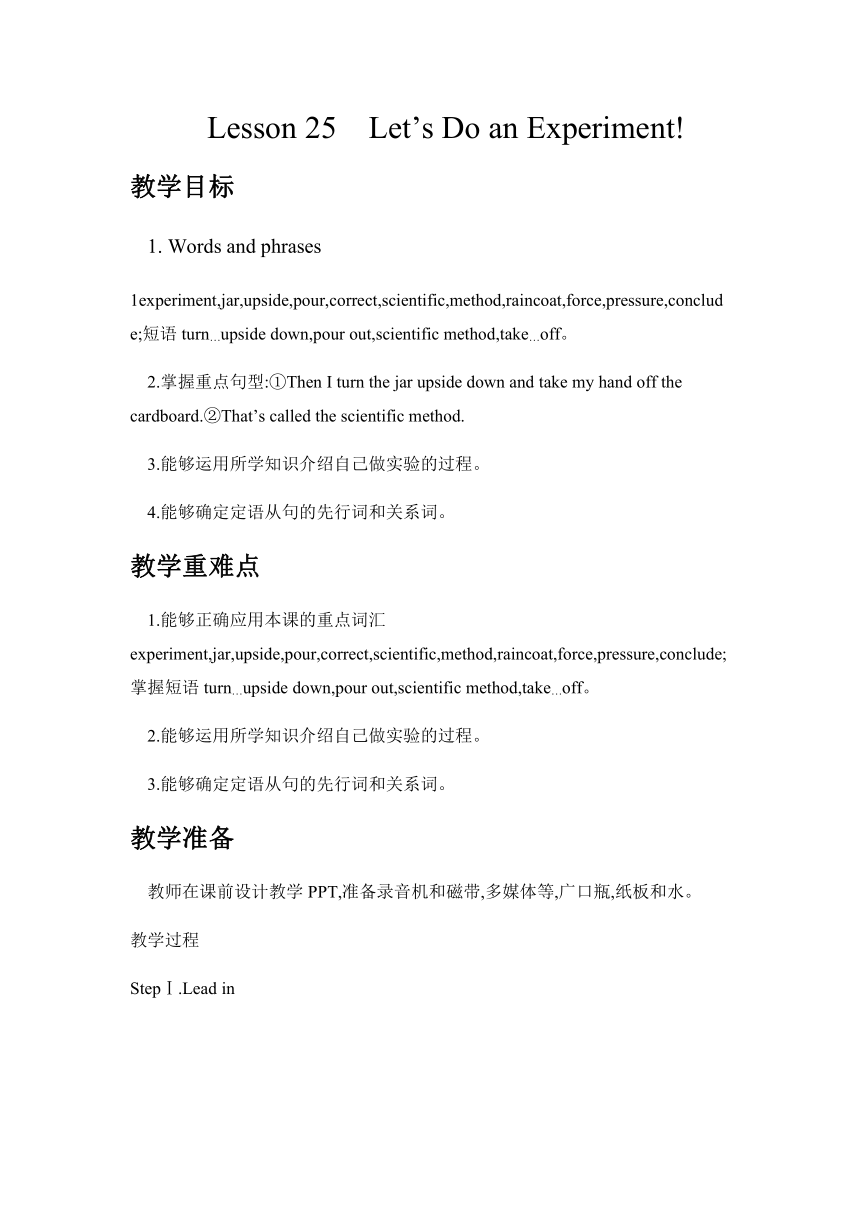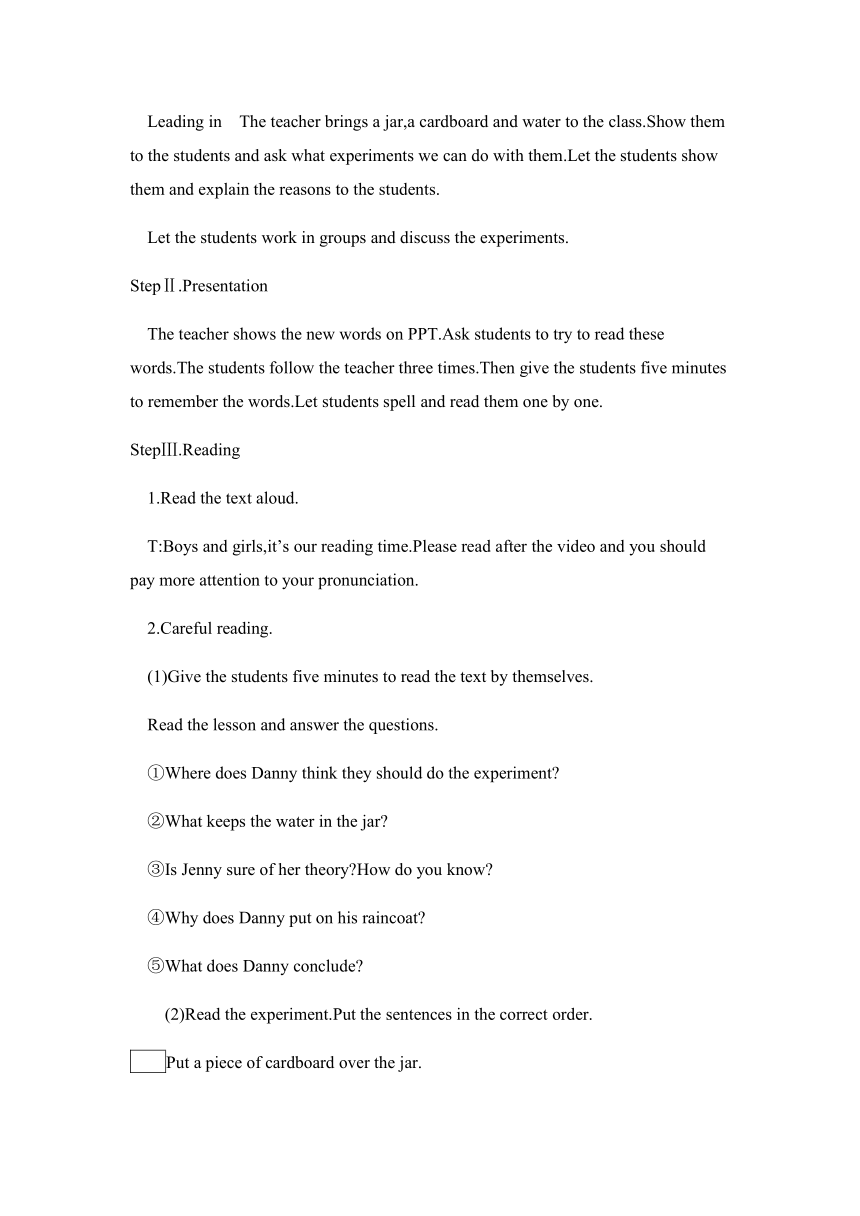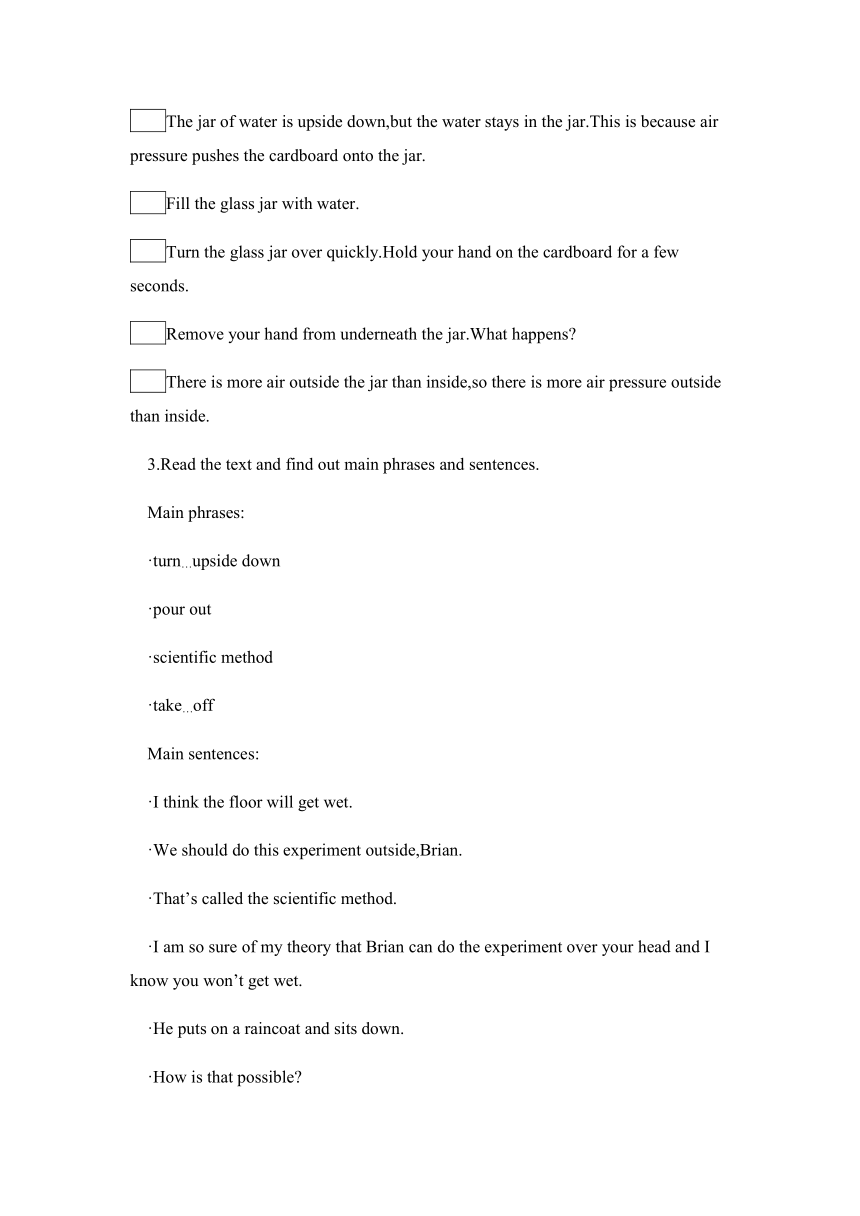冀教版英语九年级全一册Unit 5 Look into Science Lesson 25 Let's Do an Experiment! 教案
文档属性
| 名称 | 冀教版英语九年级全一册Unit 5 Look into Science Lesson 25 Let's Do an Experiment! 教案 |

|
|
| 格式 | zip | ||
| 文件大小 | 29.5KB | ||
| 资源类型 | 教案 | ||
| 版本资源 | 冀教版 | ||
| 科目 | 英语 | ||
| 更新时间 | 2020-05-28 16:45:56 | ||
图片预览



文档简介
Lesson
25 Let’s
Do
an
Experiment!
教学目标
1.
Words
and
phrases
1experiment,jar,upside,pour,correct,scientific,method,raincoat,force,pressure,conclude;短语turn…upside
down,pour
out,scientific
method,take…off。
2.掌握重点句型:①Then
I
turn
the
jar
upside
down
and
take
my
hand
off
the
cardboard.②That’s
called
the
scientific
method.
3.能够运用所学知识介绍自己做实验的过程。
4.能够确定定语从句的先行词和关系词。
教学重难点
1.能够正确应用本课的重点词汇
experiment,jar,upside,pour,correct,scientific,method,raincoat,force,pressure,conclude;掌握短语turn…upside
down,pour
out,scientific
method,take…off。
2.能够运用所学知识介绍自己做实验的过程。
3.能够确定定语从句的先行词和关系词。
教学准备
教师在课前设计教学PPT,准备录音机和磁带,多媒体等,广口瓶,纸板和水。
教学过程
StepⅠ.Lead
in
Leading
in The
teacher
brings
a
jar,a
cardboard
and
water
to
the
class.Show
them
to
the
students
and
ask
what
experiments
we
can
do
with
them.Let
the
students
show
them
and
explain
the
reasons
to
the
students.
Let
the
students
work
in
groups
and
discuss
the
experiments.
StepⅡ.Presentation
The
teacher
shows
the
new
words
on
PPT.Ask
students
to
try
to
read
these
words.The
students
follow
the
teacher
three
times.Then
give
the
students
five
minutes
to
remember
the
words.Let
students
spell
and
read
them
one
by
one.
StepⅢ.Reading
1.Read
the
text
aloud.
T:Boys
and
girls,it’s
our
reading
time.Please
read
after
the
video
and
you
should
pay
more
attention
to
your
pronunciation.
2.Careful
reading.
(1)Give
the
students
five
minutes
to
read
the
text
by
themselves.
Read
the
lesson
and
answer
the
questions.
①Where
does
Danny
think
they
should
do
the
experiment?
②What
keeps
the
water
in
the
jar?
③Is
Jenny
sure
of
her
theory?How
do
you
know?
④Why
does
Danny
put
on
his
raincoat?
⑤What
does
Danny
conclude?
(2)Read
the
experiment.Put
the
sentences
in
the
correct
order.
Put
a
piece
of
cardboard
over
the
jar.
The
jar
of
water
is
upside
down,but
the
water
stays
in
the
jar.This
is
because
air
pressure
pushes
the
cardboard
onto
the
jar.
Fill
the
glass
jar
with
water.
Turn
the
glass
jar
over
quickly.Hold
your
hand
on
the
cardboard
for
a
few
seconds.
Remove
your
hand
from
underneath
the
jar.What
happens?
There
is
more
air
outside
the
jar
than
inside,so
there
is
more
air
pressure
outside
than
inside.
3.Read
the
text
and
find
out
main
phrases
and
sentences.
Main
phrases:
·turn…upside
down
·pour
out
·scientific
method
·take…off
Main
sentences:
·I
think
the
floor
will
get
wet.
·We
should
do
this
experiment
outside,Brian.
·That’s
called
the
scientific
method.
·I
am
so
sure
of
my
theory
that
Brian
can
do
the
experiment
over
your
head
and
I
know
you
won’t
get
wet.
·He
puts
on
a
raincoat
and
sits
down.
·How
is
that
possible?
·It
is
strong
enough
to
hold
the
water.
·So
what
have
we
discovered?
·What
do
you
conclude,Danny?
Language
points
1.Then
I
turn
the
jar
upside
down
and
take
my
hand
off
the
cardboard.?
◆turn…upside
down意为“把……翻转/倒过来”,相当于turn
over。upside
down意为“正面朝下”。right
side
up意为“正面朝上”。
◆take…off…在本句中意为“使……离开/脱离……”或“把……从……拿开”。
【拓展】 take
off意为“摘掉,(飞机)起飞,脱掉”。
2.I
think
the
floor
will
get
wet.?
◆I
think…意为“我认为……”,其后可接that引导的宾语从句。在使用时,应遵循“否主反从”的规律,即否定主句,反问从句。
◆get
wet意为“变湿”。get在本句中为系动词,意为“变得…,后接形容词作表语。
3.We
should
do
this
experiment
outside,Brian.?
experiment为可数名词,意为“实验”。do
experiments/do
an
experiment意为“做实验”。【拓展】 experiment作动词,意为“做实验,进行试验”。
4.You
think
the
water
will
pour
out,Danny.?
pour
out意为“倒出,使流出,涌出”。pour在本句中表示“涌流”。
【拓展】 pour…into…意为“把……倒进……”。
5.That’s
called
the
scientific
method.?
◆be
called意为“被叫作”,是被动语态。被动语态是由“be+及物动词的过去分词”构成,其中be动词可随句子时态的变化而变化。
◆scientific为形容词,意为“科学的”。scientist为可数名词,意为“科学家”,science为不可数名词,意为“自然科学”。
◆method为可数名词,意为“方法,办法”。
6.I
am
so
sure
of
my
theory
that
Brian
can
do
the
experiment
over
your
head
and
I
know
you
won’t
get
wet.?
本句中的be
sure
of意为“对……有把握”。
7.He
puts
on
a
raincoat
and
sits
down.?
put
on意为“穿上”,为“动词+副词”构成的短语,代词作其宾语必须放在动词和副词之间。
8.How
is
that
possible??
possible为形容词,意为“可能的,合适的”,其反义词为impossible,意为“不可能的”,possibly为副词,意为“可能地”。
9.It
is
strong
enough
to
hold
the
water.?
“It
is+形容词+enough
to
do
sth.”意为“做某事是足够……的”,常用来表述某人或某物的能力或特征。在此句型中,当不定式的逻辑主语与句子的主语不相同时,常用for引出不定式的逻辑主语。该句型可以和too…to…及so…that…句型相互转换。
10.So
what
have
we
discovered??
discover为动词,意为“发现”,是指发现或找出某种自然界本来已存在,但以前未被人类发现或认识的事物。
【辨析】 find,find
out,discover,invent
(1)find意为“找到,发现”,强调“找”的结果,也可指偶然发现、碰到,其后可接名词、复合结构或that从句。
(2)find
out指“弄清楚,查明”。着重表示通过调查、分析、思考等得出结果。
(3)discover意为“发现”,指发现已存在但不为人所知的事物。
(4)invent意为“发明”,指发明原来不存在的东西。
11.What
do
you
conclude,Danny??
conclude为动词,意为“断定,推断出”,其后可接由that引导的宾语从句。
【拓展】 conclude
from意为“从……推断,从……中得出”。
StepⅣ.Listen
and
sing
along
1.Show
Let’s
Do
It!No.
4
on
PPT.
2.Read
and
discuss
the
lyrics
of
the
song
as
a
class.
3.Play
the
audiotape
for
the
song.Play
it
once
and
ask
the
students
just
to
listen.
4.Play
the
song
a
second
time
and
ask
the
students
to
sing
along.
StepⅤ.Task
1.Show
Let’s
Do
It!No.
3
on
PPT.
Try
to
do
the
experiment
in
this
lesson
yourself.
Task
tips:What
happens
when
you
use
less
water,more
water,wet
cardboard,or
different
kinds
and
sizes
of
jars?
2.Instruct
the
students
to
work
in
groups
of
three
to
try
the
experiment
and
record
the
process
using
the
scientific
method.
3.Have
the
students
try
the
experiment
with
some
variations
and
record
their
results.
4.Ask
each
group
to
present
their
findings
to
the
class.
StepⅥ.Practice
1.让我们做个实验吧!
Let’s
!?
2.将玻璃罐子迅速地翻过来。
the jar quickly.?
3.我相信她能通过考试。
I she
could the
exam.?、
4.硬纸板能承受住水。
The will the
water.?
5.那叫作科学方法。
That’s the
.?
StepⅥI.Ssummary
and
homework
25 Let’s
Do
an
Experiment!
教学目标
1.
Words
and
phrases
1experiment,jar,upside,pour,correct,scientific,method,raincoat,force,pressure,conclude;短语turn…upside
down,pour
out,scientific
method,take…off。
2.掌握重点句型:①Then
I
turn
the
jar
upside
down
and
take
my
hand
off
the
cardboard.②That’s
called
the
scientific
method.
3.能够运用所学知识介绍自己做实验的过程。
4.能够确定定语从句的先行词和关系词。
教学重难点
1.能够正确应用本课的重点词汇
experiment,jar,upside,pour,correct,scientific,method,raincoat,force,pressure,conclude;掌握短语turn…upside
down,pour
out,scientific
method,take…off。
2.能够运用所学知识介绍自己做实验的过程。
3.能够确定定语从句的先行词和关系词。
教学准备
教师在课前设计教学PPT,准备录音机和磁带,多媒体等,广口瓶,纸板和水。
教学过程
StepⅠ.Lead
in
Leading
in The
teacher
brings
a
jar,a
cardboard
and
water
to
the
class.Show
them
to
the
students
and
ask
what
experiments
we
can
do
with
them.Let
the
students
show
them
and
explain
the
reasons
to
the
students.
Let
the
students
work
in
groups
and
discuss
the
experiments.
StepⅡ.Presentation
The
teacher
shows
the
new
words
on
PPT.Ask
students
to
try
to
read
these
words.The
students
follow
the
teacher
three
times.Then
give
the
students
five
minutes
to
remember
the
words.Let
students
spell
and
read
them
one
by
one.
StepⅢ.Reading
1.Read
the
text
aloud.
T:Boys
and
girls,it’s
our
reading
time.Please
read
after
the
video
and
you
should
pay
more
attention
to
your
pronunciation.
2.Careful
reading.
(1)Give
the
students
five
minutes
to
read
the
text
by
themselves.
Read
the
lesson
and
answer
the
questions.
①Where
does
Danny
think
they
should
do
the
experiment?
②What
keeps
the
water
in
the
jar?
③Is
Jenny
sure
of
her
theory?How
do
you
know?
④Why
does
Danny
put
on
his
raincoat?
⑤What
does
Danny
conclude?
(2)Read
the
experiment.Put
the
sentences
in
the
correct
order.
Put
a
piece
of
cardboard
over
the
jar.
The
jar
of
water
is
upside
down,but
the
water
stays
in
the
jar.This
is
because
air
pressure
pushes
the
cardboard
onto
the
jar.
Fill
the
glass
jar
with
water.
Turn
the
glass
jar
over
quickly.Hold
your
hand
on
the
cardboard
for
a
few
seconds.
Remove
your
hand
from
underneath
the
jar.What
happens?
There
is
more
air
outside
the
jar
than
inside,so
there
is
more
air
pressure
outside
than
inside.
3.Read
the
text
and
find
out
main
phrases
and
sentences.
Main
phrases:
·turn…upside
down
·pour
out
·scientific
method
·take…off
Main
sentences:
·I
think
the
floor
will
get
wet.
·We
should
do
this
experiment
outside,Brian.
·That’s
called
the
scientific
method.
·I
am
so
sure
of
my
theory
that
Brian
can
do
the
experiment
over
your
head
and
I
know
you
won’t
get
wet.
·He
puts
on
a
raincoat
and
sits
down.
·How
is
that
possible?
·It
is
strong
enough
to
hold
the
water.
·So
what
have
we
discovered?
·What
do
you
conclude,Danny?
Language
points
1.Then
I
turn
the
jar
upside
down
and
take
my
hand
off
the
cardboard.?
◆turn…upside
down意为“把……翻转/倒过来”,相当于turn
over。upside
down意为“正面朝下”。right
side
up意为“正面朝上”。
◆take…off…在本句中意为“使……离开/脱离……”或“把……从……拿开”。
【拓展】 take
off意为“摘掉,(飞机)起飞,脱掉”。
2.I
think
the
floor
will
get
wet.?
◆I
think…意为“我认为……”,其后可接that引导的宾语从句。在使用时,应遵循“否主反从”的规律,即否定主句,反问从句。
◆get
wet意为“变湿”。get在本句中为系动词,意为“变得…,后接形容词作表语。
3.We
should
do
this
experiment
outside,Brian.?
experiment为可数名词,意为“实验”。do
experiments/do
an
experiment意为“做实验”。【拓展】 experiment作动词,意为“做实验,进行试验”。
4.You
think
the
water
will
pour
out,Danny.?
pour
out意为“倒出,使流出,涌出”。pour在本句中表示“涌流”。
【拓展】 pour…into…意为“把……倒进……”。
5.That’s
called
the
scientific
method.?
◆be
called意为“被叫作”,是被动语态。被动语态是由“be+及物动词的过去分词”构成,其中be动词可随句子时态的变化而变化。
◆scientific为形容词,意为“科学的”。scientist为可数名词,意为“科学家”,science为不可数名词,意为“自然科学”。
◆method为可数名词,意为“方法,办法”。
6.I
am
so
sure
of
my
theory
that
Brian
can
do
the
experiment
over
your
head
and
I
know
you
won’t
get
wet.?
本句中的be
sure
of意为“对……有把握”。
7.He
puts
on
a
raincoat
and
sits
down.?
put
on意为“穿上”,为“动词+副词”构成的短语,代词作其宾语必须放在动词和副词之间。
8.How
is
that
possible??
possible为形容词,意为“可能的,合适的”,其反义词为impossible,意为“不可能的”,possibly为副词,意为“可能地”。
9.It
is
strong
enough
to
hold
the
water.?
“It
is+形容词+enough
to
do
sth.”意为“做某事是足够……的”,常用来表述某人或某物的能力或特征。在此句型中,当不定式的逻辑主语与句子的主语不相同时,常用for引出不定式的逻辑主语。该句型可以和too…to…及so…that…句型相互转换。
10.So
what
have
we
discovered??
discover为动词,意为“发现”,是指发现或找出某种自然界本来已存在,但以前未被人类发现或认识的事物。
【辨析】 find,find
out,discover,invent
(1)find意为“找到,发现”,强调“找”的结果,也可指偶然发现、碰到,其后可接名词、复合结构或that从句。
(2)find
out指“弄清楚,查明”。着重表示通过调查、分析、思考等得出结果。
(3)discover意为“发现”,指发现已存在但不为人所知的事物。
(4)invent意为“发明”,指发明原来不存在的东西。
11.What
do
you
conclude,Danny??
conclude为动词,意为“断定,推断出”,其后可接由that引导的宾语从句。
【拓展】 conclude
from意为“从……推断,从……中得出”。
StepⅣ.Listen
and
sing
along
1.Show
Let’s
Do
It!No.
4
on
PPT.
2.Read
and
discuss
the
lyrics
of
the
song
as
a
class.
3.Play
the
audiotape
for
the
song.Play
it
once
and
ask
the
students
just
to
listen.
4.Play
the
song
a
second
time
and
ask
the
students
to
sing
along.
StepⅤ.Task
1.Show
Let’s
Do
It!No.
3
on
PPT.
Try
to
do
the
experiment
in
this
lesson
yourself.
Task
tips:What
happens
when
you
use
less
water,more
water,wet
cardboard,or
different
kinds
and
sizes
of
jars?
2.Instruct
the
students
to
work
in
groups
of
three
to
try
the
experiment
and
record
the
process
using
the
scientific
method.
3.Have
the
students
try
the
experiment
with
some
variations
and
record
their
results.
4.Ask
each
group
to
present
their
findings
to
the
class.
StepⅥ.Practice
1.让我们做个实验吧!
Let’s
!?
2.将玻璃罐子迅速地翻过来。
the jar quickly.?
3.我相信她能通过考试。
I she
could the
exam.?、
4.硬纸板能承受住水。
The will the
water.?
5.那叫作科学方法。
That’s the
.?
StepⅥI.Ssummary
and
homework
同课章节目录
- Unit 1 Stay Healthy
- Lesson 1 What's Wrong,Danny?
- Lesson 2 A Visit to the Dentist
- Lesson 3 Good Food, Good Health
- Lesson 4 Don't Smoke, Please!
- Lesson 5 Jane's Lucky Life
- Lesson 6 Stay Away from the Hospital
- Unit Review
- Unit 2 Great People
- Lesson 7 What Is the Meaning of Lift?
- Lesson 8 A Universe of Thought
- Lesson 9 China's Most Famous "Farmer"
- Lesson 10 Touch the World
- Lesson 11 To China, with Love
- Lesson 12 Guess My Hero!
- Unit Review
- Unit 3 Safety
- Lesson 13 Be Careful,Danny!
- Lesson 14 Accidents Happen
- Lesson 15 My Helmet Saved My Life!
- Lesson 16 How Safe Is Your Home?
- Lesson 17 Staying Safe in an Earthquake
- Lesson 18 Never Catch a Dinosaur
- Unit Review
- Unit 4 Stories and poems
- Lesson 19 A Story or a Poem?
- Lesson 20 Say It in Five
- Lesson 21 The Fable of the Woodcutte
- Lesson 22 The Giant(Ⅰ)
- Lesson 23 The Giant(Ⅱ)
- Lesson 24 Writing a Poem
- Unit Review
- Unit 5 Look into Science
- Lesson 25 Let's Do an Experiment!
- Lesson 26 Keep the Candle Burning
- Lesson 27 Planet Danny
- Lesson 28 The Study of Living Things
- Lesson 29 DNA—The Story of You
- Lesson 30 Science Affects Us
- Unit Review
- Unit 6 Movies and Theate
- Lesson 31 A movie or a Play
- Lesson 32 Moving Pictures
- Lesson 33 The Fisherman and the Goldfish(Ⅰ)
- Lesson 34 The Fisherman and the Goldfish(Ⅱ)
- Lesson 35 Theatres Are Fun!
- Lesson 36 Making Plays Is Fun
- Unit Review
